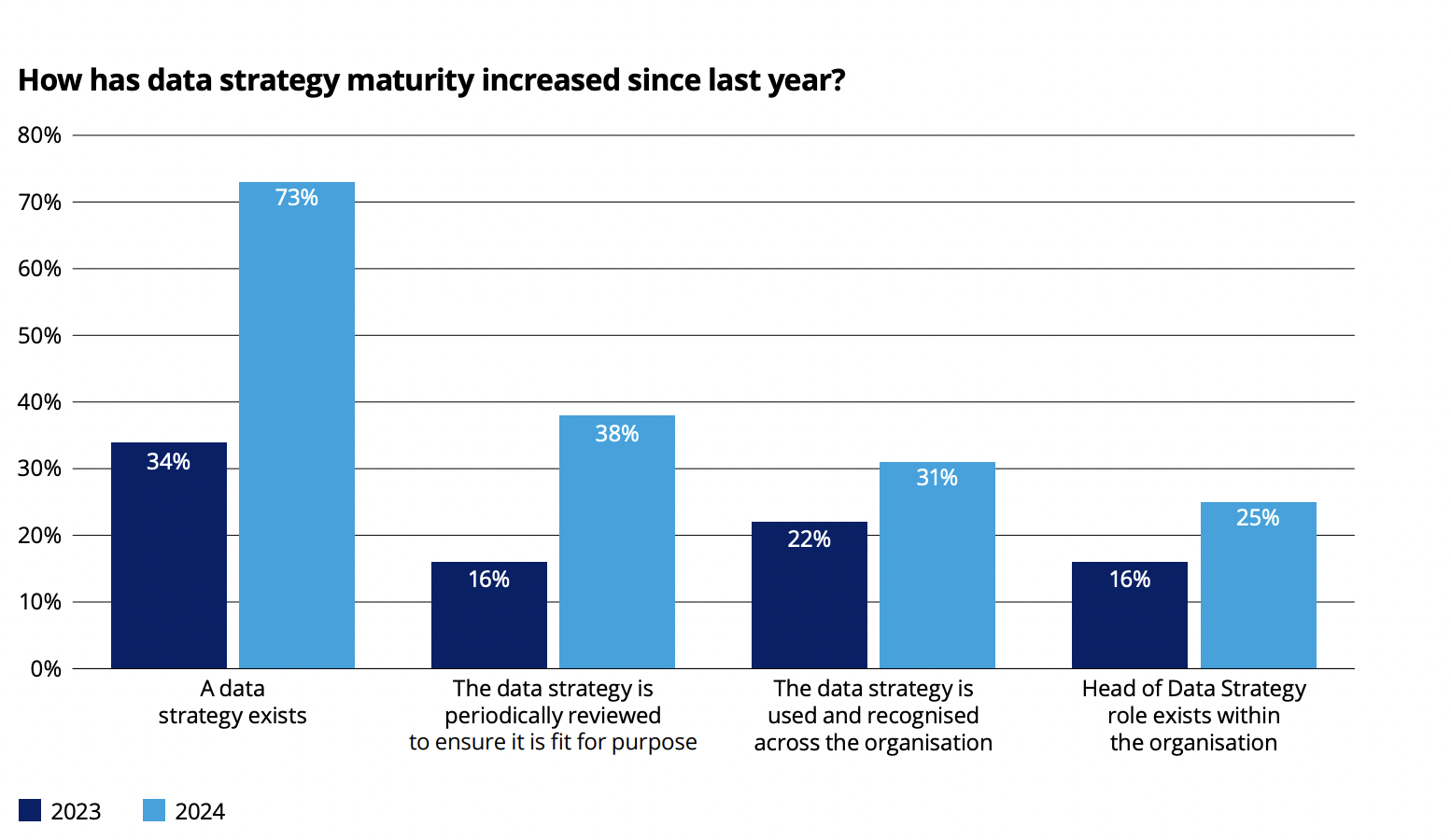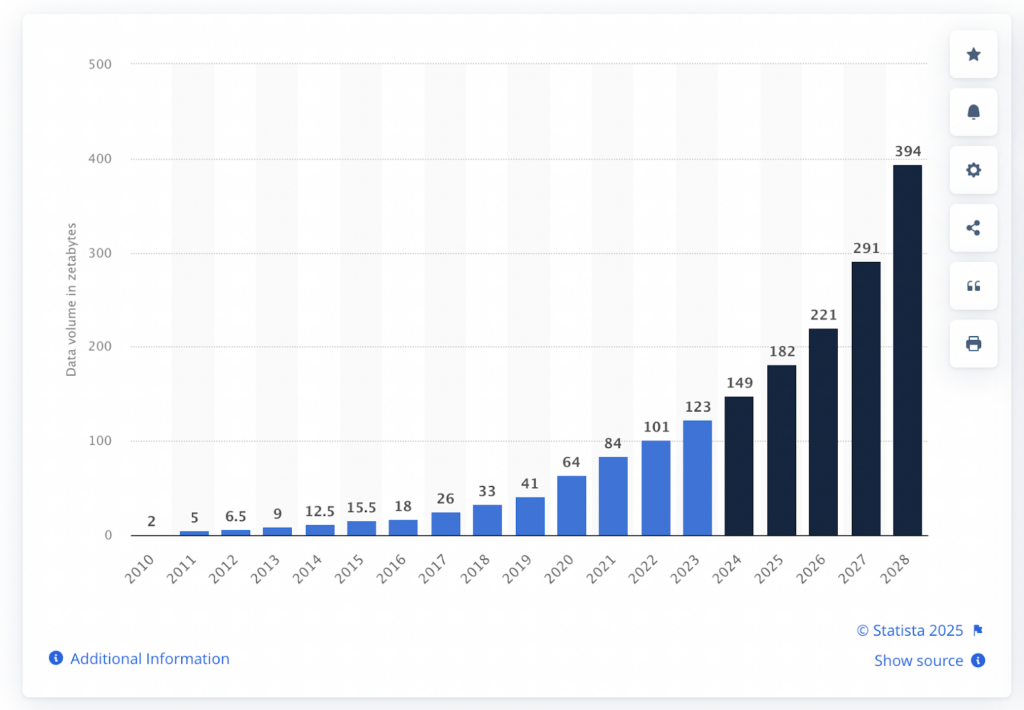
The CDAO Power Shift: From Data Keeper to Business Driver in 2025
Data is the new black! And CDA(I)Os are about to take center stage.
But the roles are changing. In fact, we’re now in a Darwinian moment of survival of the fittest: it’s time to adapt or die in today’s corporate jungle. If you don’t keep up, you risk going the way of the Neanderthals.
For a long time, data wasn’t seen as a valuable asset. The role of Chief Data Officer (CDO) first emerged in the early 2000s as a back-office function. But with the dawn of analytics, and as data jumped from a sidekick to a superhero position, so did CDOs.
Today, data is no longer a byproduct, according to Gartner. Not just something to collect (and too often ignore) but an asset driving business decisions and strategy. For data leaders, it’s time to play the music, turn on the lights, and make data drive real business value.
Are you ready?
The Rise of the CDAO
So you finally got your place at the table, and you’re not the only one. Today, more than 80% of companies have a CDO or an equivalent role. Hardly a surprise when research from KPMG shows that companies investing in data and analytics are enjoying a profitability and performance increase of at least 11%.
You’ve been acting as the conductor, the composer, and the performer of a company’s data strategy, responsible for transforming collected data into actionable insights.
This role is not only about keeping the data clean (though that’s important). It’s about using data to create business value, develop new data products, and even create new revenue streams. It’s about transforming data to provide insights that improve decision-making, boost productivity, and lead to new business opportunities.
And yet, many of today’s data leadership positions are still mostly mid-level. Plus, in most cases, organizational data still doesn’t play the role it should in business decision-making. So why has the CDAO (and similar roles) gained so much traction in the last few years?
The answer lies in the strategic importance of data in today’s competitive landscape. A survey by West Monroe found that executive leaders aged 25-45 view the CDO role as one of the most important in the near future, coming in second only to the Chief AI Officer.
The need for data leaders has only grown more urgent with the rise of artificial intelligence, generative AI, and agentic analytics. The connection between high-quality, well-governed data and AI is clear. After all, for a successful AI and GenAI implementation (that actually pays off on the business side of things), it’s crucial to make sure the data is AI-ready.
But the need for CDAOs doesn’t just stem from the rise of AI. It’s just as much about powering business growth. The momentum is clear: Deloitte reports that as of 2024, 73% of CDOs have data strategies in place (up from 61% in 2023).
Data has become the currency of modern business. It’s how companies stay competitive, drive new products, and understand their customers. And 2025 marks the moment when these multi-year data and AI strategies shift from planning to powerful execution.

73% of CDOs have already had a data strategy in place since 2024, up from 63% in 2023. Source: Deloitte Chief Data Officer Survey, 2024
And don’t think for a second that the role of the CDAO is limited to tech companies or data-driven firms. Every business, regardless of industry, needs a data leader. Whether it’s banking, healthcare, or retail, companies are waking up to the fact that data can present new opportunities and provide a competitive edge.
Not an Easy Road Ahead
The role comes with its fair share of challenges. CDAOs are expected to deliver fast results and lead organizations in data-driven innovation. All while changing the landscape within their own organization. Let’s look at some of the roadblocks you might have to face.
High Turnover and External Pressure
We don’t have to tell you that being a CDA(I)O is no walk in the park. It’s a high-pressure role. It’s still a new position, and many companies don’t fully understand what a CDAO does.
Ever feel like your other senior management colleagues just don’t really get what you do? It’s frustrating, which leads to high turnover. When things don’t move fast enough, or results aren’t clear right away, CDAOs can find themselves out the door.
In times of economic uncertainty, organizations expect clear, measurable results like boosting profits or customer retention. And if the CDAO doesn’t deliver quickly, pressure builds, and patience wears thin.
Factor in the challenge of weaving AI into your data strategies (hint: not something you can rush through overnight), and you’ve got a high-stakes job that feels like a balancing act. Since the role is still evolving, CDAOs are often the first to be let go if things don’t go perfectly, even though their work is crucial to the company’s future.
Managing Growing Volumes of Complex Data
Data is growing fast. Each year the amount of data collected increases by approximately 23%. By 2025, it’s forecast to reach over 181 zettabytes (1 trillion GB). That means you have to manage much bigger and more complex datasets than before.
On top of that, data has traditionally been siloed in different departments, which makes it hard to get a full picture of the company. Here, too, AI and GenAI projects increase complexity.

The volume of data/information created, captured, copied, and consumed worldwide from 2010 to 2023, with forecasts from 2024 to 2028 (in zettabytes).
Source: Statista.com
Ensuring Quality and Governance
Historically, governance was a relatively static process. For data leaders, governance meant making sure data is handled the right way and accessed only by the right people while keeping in line with relevant industry regulations. Setting up access rules, keeping sensitive information secure, and staying compliant.
That’s still a thing! And it’s an ever-growing concern, with the EU AI act of 2024 coming into force and the number of AI regulations in the US growing by over 53% in the US alone. In 2025, governance is so much more, and with the GenAI revolution, it’s more important than ever.
Your data needs to be in shape so that your GenAI produces fast and precise responses that your team and customers can be 100% confident in. It’s a big task to run regular audits and checks to make sure the data is accurate, complete, and trustworthy.
Building a Data-Driven Culture
Don’t forget the people. And I’m not just talking about your data team. You play a big role in making sure data is valued across the company and accurate enough for all departments to trust it to power business decisions.
It’s the CDAOs job to encourage everyone, from the top to the bottom, to make decisions based on data. It’s not enough to give people access to data; they need to know how to read it and use it to make smart choices.
Self-service analytics tools let people explore data on their own, but the CDAO ensures they know how to pull useful insights from it, turning raw data into actions. A lot of CDAOs are turning to data literacy programs, but teaching people to “speak data” often misses the mark.
This March, the brightest minds in data and analytics head to both U.S. coasts for three epic events. Will we see you there?
🔹 March 3-5, Orlando, FL: Gartner D&A Summit 2025. BOOTH 1106
🔹 March 10-13, Las Vegas, NV: HumanX AI Conference
🔹 March 17-21, San Jose, CA: NVIDIA GTC 2025. BOOTH 2010
We’re rolling in with demos that’ll unravel your tangled data faster than you can say “AI-ready.” Think speed, precision, explainability, governance (and zero hallucinations).
❇️ Be sure to swing by our booths and say hi!
🎁 Score some awesome swag (and maybe even some cool prizes)
💬 And let’s chat about your data, governance, and AI dilemmas. We might just have the solution you’ve been hunting for.
So, mark your calendars! Your road to smooth auto-AI-ready data, augmented governance, and trustworthy self-service analytics starts here.
Charting Your Path Forward
The challenges CDAOs face may seem daunting, but they’re not impossible. They actually offer unique chances to innovate and lead. Here’s how you can tackle each hurdle I mentioned head-on with practical, proven approaches.
Establishing Value and Stability
When the pressure’s mounting and stakeholders are demanding quick wins, you need a strategic approach. You must make sure that your data is ready for everything AI.
Apply automated processes to ongoingly maintain your data’s AI-readiness to accelerate AI and GenAI implementation projects and cut costs. By showing the value of data-driven initiatives early (whether it’s improving profitability or customer retention), you can establish yourself as a key contributor to your company’s success.
Managing Data Complexity
In a world where data volumes are exploding exponentially, traditional approaches just won’t cut it anymore. One key goal should be to break down silos and bring everything together across teams and tools to help make data available for better decisions across the entire business.
However, managing growing data volumes requires a modern, scalable, and automated infrastructure.
To thrive today, data leaders must focus on automating data processes, integrating systems across departments, and streamlining workflows through solutions like semantic data fabric.
Enable a single source of truth for your data for the entire organization while making sure data is rich in meaning and context for your AI-based projects and agentic analytics. This way, your data will be trustworthy and always ready for self-service analytics access for any technical or non-technical user.
Strengthening Governance
Quite often, people hear “governance” and think of rules, restrictions, and red tape. But done right, it’s none of those things. What’s more, with increasing regulatory pressure and the need for trustworthy AI, governance becomes your competitive advantage.
Things are made easier by creating a single source of truth. Teams thrive when they can trust their data. Decisions get made faster, silos crumble, and arguments over “whose data is right” vanish.
So what should you do? Keep your data semantically coherent and aligned. Be precise about verbiage and terminology across departments. Use automated data classification to save time and money.
Automate AI guardrails and implement real-time lineage and sensitive-info tagging. Make sure your compliance workflows adapt as your data grows and changes.
You can achieve all of the above by investing in augmented governance. This will help you automatically create a shared language that everyone, from data pros to business users, can rally around.
Building Trust Through Data Culture
Creating a data-driven culture isn’t simply about tools and technology. Its real focus should be on making data accessible and meaningful to everyone in your organization. And investing more time and budget into data literacy programs might not be the path that will take you there. Teaching your data to “speak human” is a better approach.
“How?” I hear you scream. Make sure your data is semantically aligned, organize (and automate) all important metadata, and, I’ll say it again, fill in those governance gaps. That’s the secret ingredient to building trust.
And trust is everything when it comes to creating a data culture. If you build it, they will come.
The Future of the CDAO: What’s Next?
So, if 2025 is the year of the CDAO, what can we expect in the future? The role is already growing in power. According to Gartner, 81% of data leaders say that they have more influence on business decisions than they did just two years ago.
Important decisions that drive innovation and growth, where senior management from the wider organization are coming to you for the answers. And with the increasing importance of artificial intelligence, GenAI, and agentic analytics, the CDAO’s role is likely to expand even further.
One potential shift on the horizon is the rise of the Chief AI Officer (CAIO), a role that could overlap or even merge with the CDAO. In some cases, companies are already asking their CDAOs to take on AI strategy, adding another layer of complexity to an already multi-faceted job.
The key to the future of the CDAO is adaptability to change. Data leaders need to evolve their skill sets, embrace emerging technologies, and navigate the complexities of business culture. They must work hand-in-hand with the CIO, CTO, and other IT leaders to create a data strategy that drives business growth.
In other words:
- You must remain professionally agile
- Encourage a mindset of continuous improvement
- Stay updated with the latest tools and trends, and
- Foster a culture of innovation to help your organization stay ahead.
Today, data leaders are in the perfect position to take the reins in the tech world. With the right skills, vision, flexibility, and strategy, the CDA(I)O will lead organizations into a new era of data-driven and decision-centric innovation.
So, buckle up! 2025 is going to be your year to become “queens and kings of the jungle.”
You are a CDAO. Let me hear you roar!




